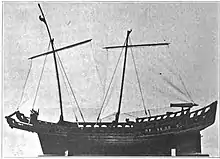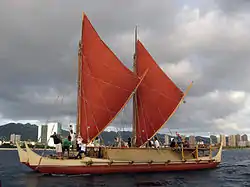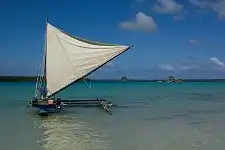Lancang (ship)
Lancang (also written as lanchang or lancha) is a type of sailing ship from Maritime Southeast Asia. It is used as warship, lighter, and as royal ship, particularly used by the people of Sumatran east coast,[1] but can also be found in the coast of Kalimantan.[2]

Etymology
The name comes from the Malay word lancang which means "swift".[3]
Design and construction

The earliest mention of the lancang is from Julah inscription dated 844 Saka (923 AD), which explains the orders of the King Sri Ugrasena on certain rules. The inscription mentions terms for boats such as "lancang", "talaka" and "jong".[4] It is the oldest form of boat building in the Indonesian archipelago and has been recorded in Gilimanuk, Bali. The boat builders are known as undagi lancang.[5] According to the Ngantang inscription, lancang were also used in Majapahit-controlled areas. The lancang of this era has no sails.[6]
Lancang have overhanging square sterns above a sharp waterline stern.[1] Lancang usually have 2 masts, but single and tri-masted vessels are also recorded.[1] Historically they were steered using double quarter rudders, but in the 18th century they also used axial rudders mounted at the sternpost.[7] The smallest lancang were 9.1 m long, with a 1.8 m beam, draft of 0.5 m, and a 1.2 m freeboard. These smaller boats could carry cargo of around 300 kg and were crewed by 4 men,[1] while the largest is about 26 m long.[3] Lancang from older era is rigged using tanja sails, but dipping lug sails or fore-and-aft sails are used after the arrival of the European. Lancang has "clipper" bow, with triangular fore-gallery for anchor, which also acts as bowsprit. Headsails may be used at the bow. The hull is carvel-built, built with style very similar to European ships. They are usually armed with pivot guns.[1]
In Bandar, Malaysia, a type of lancang called lancang To'Aru is built.[Note 1] It is similar to lancang in hull, but with projecting or hanging rectangular platform over the bow, in which two swivel guns are mounted. The sail is using fore-and-aft sail in gaff and boom on two masts. Boats which such rig on the east coast of Malaya generally carry long topmasts and jib-booms for light-weather sails.[1]

Uses
Lancang were primarily used for war[8] and as merchant vessels. Portuguese records mentioned their use as barges or lighters.[9] The intercourse with European people decreased Singaporean piracy in 1820s, although it still exist, using smaller ships than formerly used, for several decades to come. Around Singaporean waters, Malay pirates used lanchang carrying 25-30 men, with shallow draft, making them easy to conceal in mangroves. They generally used lancang between 15 and 18 m long, 3.4-4 m in beam, and with 1.5-2.1 m draft.[10]
In the 20th century, Malay states used lancang as cargo boats.[11] Along the Sumatran coast, ethnic Malay rajas (kings) used them as state ships.[1] In Selangor, this royal vessel is dedicated to the service of the spirits, also called kapal hantu (ghost ship), which are laden with offerings, then set adrift to propitiate the demons of the sea.[1][8] In Sumatra and Kalimantan, lancang play an important role in harvesting ceremonies and sometimes the boats are used in offering ceremonies to the god. Sometimes dragon heads are carved on the bow as a representation of power that maintains humans' safety.[2]
In traditional culture
In Riau, Indonesia, a traditional story of the lancang kuning (yellow lancang) was taken as a metaphor for the ruler's power and the state. A popular (poem) explains this:[12]
Lancang kuning berlayar malam
Haluan menuju ke laut dalam
Kalau nakhoda kurang paham
Alamat kapal akan tenggelam
Translation:
The lancang kuning sails at night
Her bows towards high seas
If her skipper is ignorant
She is bound to be wrecked
See also
Note
- To'Aru was one of the council of four great chiefs of Selangor, who in former days had much power, and to whom was entrusted the election of the Sultan. To'Aru was the most powerful of these four great chiefs, and took his name from a district called Aru, in Sumatra, from which he came over to settle in Selangor. Aru is probably the same as the word "Aru" (also eru or 'ru), which means a casuarina-tree. Bandar was the name of the place (on the Langat River) where To'Aru lived.
References
- Smyth, H. Warington (May 16, 1902). "Boats and Boat Building in the Malay Peninsula". Journal of the Society of Arts. 50: 570–588 – via JSTOR.
- Sukendar, Haris (1998). Perahu Tradisional Nusantara (Tinjauan Melalui Bentuk dan Fungsi). Jakarta: Departemen Pendidikan dan Kebudayaan.
- Manguin, Pierre-Yves (1993). "Trading Ships of the South China Sea. Shipbuilding Techniques and Their Role in the History of the Development of Asian Trade Networks". Journal of the Economic and Social History of the Orient. 36: 253–280 – via JSTOR.
- Poesponegoro, Marwati Djoened and Notosusanto, Nugroho (2008). Sejarah Nasional Indonesia. Jakarta: Balai Pustaka.
- Soejono, R. P. (1976). "Tinjauan tentang Pengkerangkaan Prasejarah Indonesia". Aspek-aspek Arkeologi Indonesia no. 5, Proyek Pelita Pembinaan Kepurbakalaan dan Peninggalan Nasional.
- Pinardi, Slamet and Winston S. D. M. (1992). Perdagangan pada masa Majapahit, 700 Tahun Majapahit, 1293-1993 Suatu Bunga Rampai. Surabaya: Dinas Pariwisata Daerah, Propinsi Daerah Tingkat I Jawa Timur.
- Mitman, Carl W. (1923). "Catalogue of the Watercraft Collection in the United States National Museum". Bulletin. 127: 1–298.
- Wilkinson, Richard James (1908). An Abridged Malay-English Dictionary (Romanised). Kuala Lumpur: F.M.S Government Press.
- Dalgado, Sebastião Rodolfo (1988). Portuguese Vocables in Asiatic Languages: From the Portuguese Original of Monsignor Sebastião Rodolfo Dalgado. Asian Educational Services. ISBN 9788120604131.
- Anonymous (October 1827). "Asiatic Intelligence". The Asiatic Journal and Monthly Register for British and Foreign India, China, and Australia. 24: 507.
- Smyth, H. Warrington (1906). Mast and Sail in Europe and Asia. John Murray.
- Effendy, Tenas (1969). Tjatatan tentang "Lantjang Kuning". Pekanbaru.





.jpg.webp)